Rug Damage
This page discusses some of the kinds of damage that can affect new and old handwoven rugs. If buying an older rug, be sure to inspect it carefully for any of these conditions.
Moth Damage….

A female clothing moth laid eggs in the pile of this 10 year old Tabriz, the eggs hatched, and the larvae ate a good chunk of the nap as they grew and prepared to metamorphose into adults.
This Tabriz has a wool pile and cotton warp and weft. The wool was much tastier than the cotton, and the feeding larvae cleaned off the nap but left the cotton foundation untouched. You can see the ghostly remnant of the design under the warps and wefts; the larvae only ate the nap–the bottom part of the knot still exists on the back of the rug.
The skeletal appearance of the bald patch in this rug is very typical of bad moth damage. This rug could be repaired by reweaving, but the repair would be expensive since you would have to pay a specialist craftsperson western labor rates to redo work that had originally cost $4 or $5 dollars a day when the rug was woven. Rarely does it make economic sense to reweave more than a few square inches of moth damage.
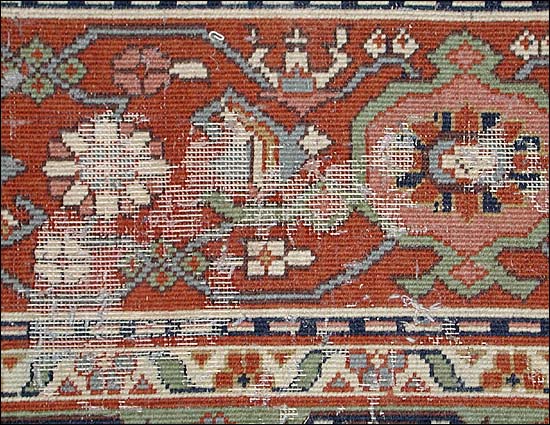
This picture shows the back of a different area of the same rug pictured above. Here young moth larvae (little white worm-like critters) crawled under the edge of the rug, and began to eat the woolen knots from the back. This kind of damage is almost always limited to 12" or 15" in from the edge of the rug–the larvae don't usually travel further under the rug.
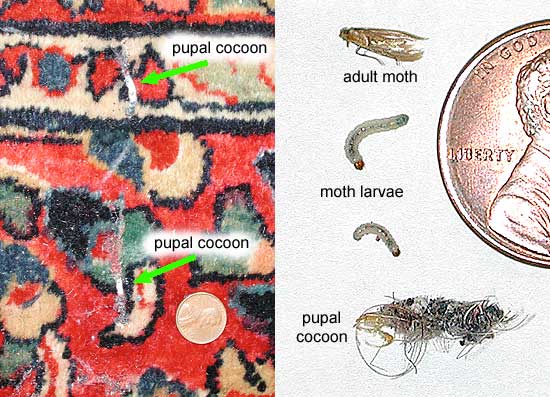
This composite picture shows the wildlife at work on a Sarouk (on the left), and closeups of an adult clothing moth, naked moth larvae, and a pupal cocoon (on the right) with pennies for scale. You can see the cobwebby filaments often left by the larvae as they feed on the rug prior to building cocoons. The brownish-black ends of the moth larvae are the heads with their hard mouth parts. The larvae feed by clipping off wool fibers and masticating them. The granular, sandy looking junk at the bottom of the photo on the left is moth larvae excrement. Often it's the same color as the wool the larvae ate!
In many cases moth damage is not evident from the face of the rug. From the face the nap looks fine, it's just that the back of the knot holding the pile into the rug has been eaten away! Even so, a rug with this kind of damage can be quite presentable and useable. You would think you could just pluck the nap from the face of the rug in chunks, but this is not so. The individual shoots of yarn that form the pile interlock with each other to resist shedding.
Moth damage like this (carpet beetle damage looks almost identical) doesn't need a "repair" in the usual sense–the rug looks fine from the face. Small areas of moth damage on the back of a rug are probably best ignored (as long as there are no larvae still munching away!). Large patches of damage are sometimes latexed, with the idea that the latex spread over the damaged area will glue in the pile. The efficacy of this kind of repair is debatable. Once applied, latex is almost impossible to remove. The problem is that latex gets harder and harder as it ages, and sometimes causes fibers to which it's been applied to break if the fibers are manipulated (as in folding or rolling a rug).
If you are inspecting a used or older rug with an eye toward buying it, be sure to fold over the edges and check for this kind of semi-hidden damage!
Color Run….
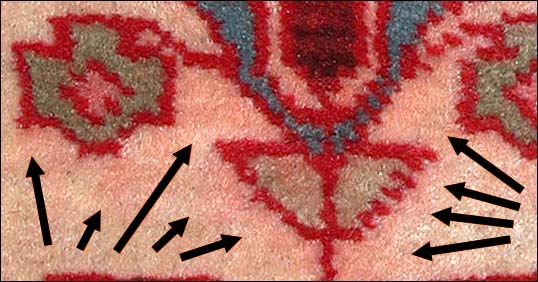
This closeup shows the face of a Hamadan rug with a fair bit of color run: the red dye has bled into the ivory field. This kind of damage can happen to any sort of rug, although it is a little more common with country or village types. Color run can happen to "vegetable" dyed rugs as easily as to synthetic dyed rugs; actually, good chrome (synthetic) dyes are more resistant to color run than some vegetable or aniline dyes.
If color run is going to happen, it usually happens early in the life of a rug. Most rugs are water-washed as soon as they're taken from the looms, and sometimes one color (usually red, sometimes black, rarely blue or pastel shades) will bleed in this initial water wash. Most rug dyes are acid-fast in the sense that an acidic environment helps stabilize the dye and reinforce the bond of the dyestuff to the wool. Run color is usually caused by the washwater being basic in pH. The alkalinity of the wash makes susceptible colors bleed. One bit of "old wives" advice is to add a little white vinegar to the water if you're going to wash your rug. This makes the washwater more acidic and lessens the chances of running a dye. (Here's more information about cleaning Oriental rugs.)
A problem is that the initial wash that caused a color to run is often fixitive: the color bled initially, but now is more stable. This makes color run very difficult to remove. The rug could be chemically stripped, but this usually affects other colors, and sometimes is so harsh as to affect the strength and appearance of the wool itself (you can strip color from a rug with a strong alkali like caustic soda, but the soda can partially dissolve the sheath of the wool fiber, changing its texture and reflectivity).
The best advice is to learn to recognize color run, and to avoid buying a rug that's badly run. The run is not "surplus dye dust;" the run won't "fade away in a few months;" color run can't be permanently fixed by camouflaging the run area with powdered chalk.
Once you've been sensitized to seeing color run you can find it in many rugs (try looking at Belouch and Afghans!). We've knowingly purchased (and sold) many rugs with color run because there was something else so desirable about the rug that we liked it in spite of the color run. The touchstone here is obviousness. If the run is so apparent that you immediately notice it instead of the overall integrity of the colors and design, the rug should probably be passed over, or purchased at a big discount. If you have to look closely to find color run, ignore it as unimportant.
Curled Edges and Corners….
Many kinds of rugs want to curl their edges under. Most often this tendency increases as the rug becomes more tightly knotted, and the effect is even more pronounced if the rug is both tightly knotted and thickly napped (like some contemporary Bijars). In a rug like this, the width at the base of the foundation is actually less than the width at the surface of the pile. This is because the yarn that makes up the pile is tightly compressed where it is knotted at the foundation, but opens up as it is unconstrained at the surface of the rug.
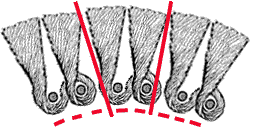
If you measured carefully enough, you would find that each knot element is slightly wedge shaped, with the apex of the wedge at the base of the rug. The width of each knot element at the very top of the pile tends to push its neighbors outward, and this makes the rug want to curl its edges under. It is often easier to roll up a fine, thick rug with the pile facing outward (rather than inward) because of the natural tendency of the rug to curl to its back.
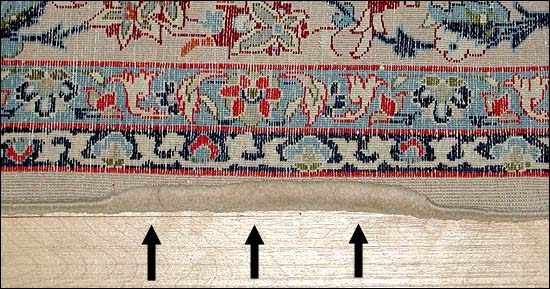
This fine Isphahan (wool on silk warp and weft) from Iran has a very badly curled edge. The curl in this Isfahan is partly caused by the wedge effect typical of fine rugs, but in this rug the primary cause is by too much tension in the weft strings (the wefts run across the width of the rug) in the area of the curl. A good weaver needs to continually adjust tensions as s(he) weaves to avoid pulling the edges of the rug under.

This same Isphahan has curl problems in other places, like this corner.
Curled edges and corners are real problems. It is impossible to train the edge to lay flat by uncurling it, forcing it against the floor, and stepping on it. To be permanently flat the edge needs to be slit in a number of spots to relieve the too-tight wefts, then carefully re-sewn to be strong enough to resist all the wear the edge binding absorbs.
Thin Field….
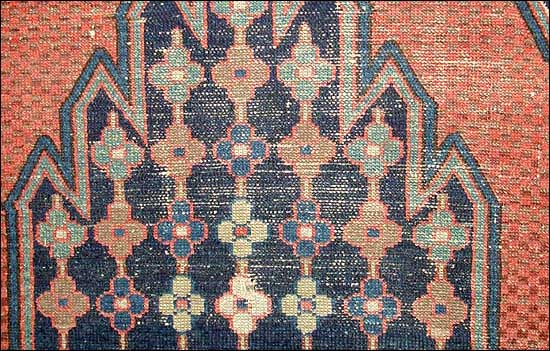
Oriental rugs wear from the top down: over the decades the pile gets lower and lower. No matter how old and unusual, a rug looses value when the pile becomes so thin that warp and weft begin to show from the face of the rug. This old Mazlahan from Iran is nearing the end of its decorative life as the colored wool tufts rising from each knot gradually wear away.
There is no real repair for this condition. Usually a largish area of the pile will be very thin, and the labor to reweave the whole area would be prohibitively expensive. Even if the cost was not so high, it is very difficult to match texture and color when reweaving an area that is so thin. Often rewoven knots can't be tied as tightly and packed as densely as the original knots, and with the pile so thin, the top of the knot can be easily seen. The mismatch in appearance between the new knots and the original weave is often worse than living with the worn areas.
A common fixup for old, thin rugs is to color the exposed warp and weft to match the surrounding design, and in this way camouflage the very worn areas. Most often this is a quick and dirty job done with colored markers. The dyes used in the markers are nothing like wool dyes, and can fade, change shade, transfer to underlying wall-to-wall or floor, or even wash out if the rug is cleaned. Painting the face of a rug is not a horrible crime if it allows an otherwise tired and unappealing rug to find a good home and a few years more use (we've painted our share of old rugs). The key is full disclosure. Don't mistake the rug with colored-in warp and weft for a piece with original (even if millimetricaly thin) pile. Be careful if the old rug you're considering is very, very thin. The painted rug is worth a fraction of the piled rug.
Fold Wear….

This old Shirvan from the Caucasus has lots of problems, but the most damaging is probably fold wear. When this rug was woven, warp tensions got so uneven in one area that a wrinkle was woven into the rug. Such woven-in wrinkles are more often found in rugs made with wool warp and weft (because wool is so elastic), but they happen in cotton foundation rugs as well. The wrinkle made a ridge running in from one edge, forcing the nap and foundation upward. Because this wrinkle in the rug was higher than the surrounding area, it caught more foot traffic and wore more quickly. Not just the nap wore. When the nap was gone, traffic eventually began to wear through the foundation warp and weft. After 75 years' use, there are several holes and a long weak strip running across the rug.
At this point there is little repair possible for this kind of damage. When inspecting a rug for possible purchase, particularly if the rug is a villiage or country type woven on wool warp and weft, turn it over and look carefully for woven-in wrinkles or puckers. If wrinkles are present, best to pass the piece for another.
Patches and Darns….
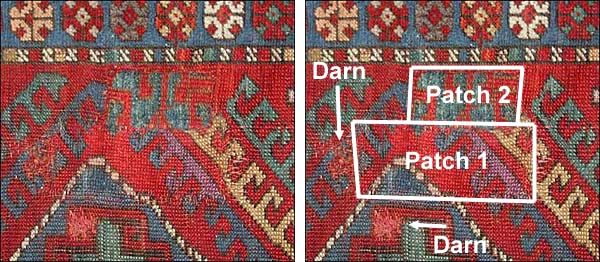
This old Kazak from the Caucasus has two big patches and several darns. Patch 1 is quite old, and may have been specially made to match the pattern lost to the hole. Warp and weft in this patch run in the same direction as the rug, and this patch is sewn into the rug. Still, note how the purple latchooked element in Patch 1 no longer matches the color of the continuing latchook in the main rug. The colors may have been the same when the patch was inserted, but over the years colors in the patch and colors in the rug aged differently, so now the patch is easy to pick up.
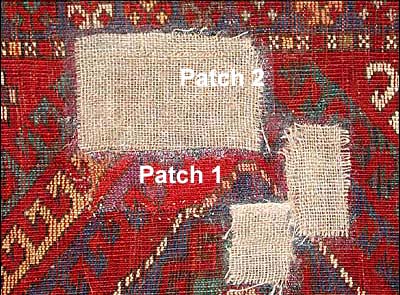
Patch two is much more recent and much more crudely done. It's a piece from a Hamadan rug (not a Kazak), and it's glued into the rug with its warp running at right angles to the warp of the main rug. From this picture of the back of the rug you can see how Patch 2 has been inserted into the rug and then reinforced with a scrap of burlap and latex cement (the two darned areas have similar reinforcements).
Two small holes near these patches have been "repaired" by simply darning the area with a back and forth stitch, much as your grandmother once darned socks. This makes a poor repair. The darned area is harder that the surrounding rug and doesn't match at all the texture of the main rug.
Look carefully (looking at the back of the rug is best) for patches, darns, joins, or other surgery done to any rug you are considering for purchase. Even if very well done, a patch or repair significantly diminishes the value of a rug.
Eroded Ends and Corners….

Missing end borders and corners are among the most common problems we see with older rugs. Notice that the Hamadan rug on the left has three borders: an ivory main border and two identical flanking rust colored guard borders. Unfortunately, the structure at the end of the rug that tied the warps together so that knots could not slip off the warps and be lost wore away, and over time almost all of the guard border running across the end of the rug has disappeared. A common fix is for a repair person to ravel back the end of the rug so that all the end guard border is gone, then finish the end with a twist line or by overcasting. Many people don't realize that once their old rug was 2", 3", or 6" longer!
The Shiraz pictured on the right is in a bad way as well. Its corner is badly eroded (chewed by little puppy Fofo?), and the repair to this corner (inserting missing warp and reweaving) would cost several times what this small rug is worth.
If considering an older rug, check to see that all the rug is really there (that the multiple borders go all the way around the rug). A rug that has had its sides or ends reduced is worth substantially less than a rug that is complete.


